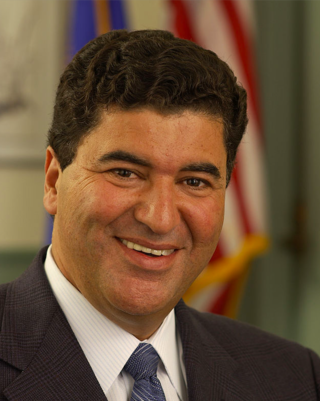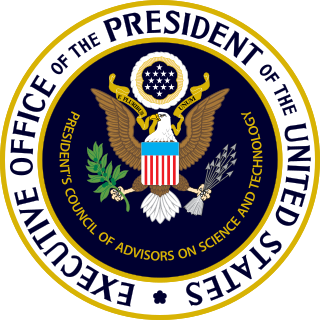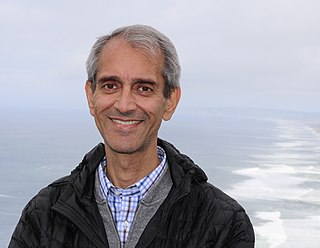Stanford University School of Medicine is the medical school of Stanford University and is located in Stanford,California. It traces its roots to the Medical Department of the University of the Pacific,founded in San Francisco in 1858. This medical institution,then called Cooper Medical College,was acquired by Stanford in 1908. The medical school moved to the Stanford campus near Palo Alto,California,in 1959.

The Rockefeller University is a private biomedical research and graduate-only university in New York City,New York. It focuses primarily on the biological and medical sciences and provides doctoral and postdoctoral education. It is classified among "R2:Doctoral Universities –High research activity." Rockefeller is the oldest biomedical research institute in the United States.

Elias Zerhouni is an Algerian-born American scientist,radiologist and biomedical engineer.
James Donald Meindl was director of the Joseph M. Pettit Microelectronics Research Center and the Marcus Nanotechnology Research Center and Pettit Chair Professor of Microelectronics at the Georgia Institute of Technology in Atlanta,Georgia. He won the 2006 IEEE Medal of Honor "for pioneering contributions to microelectronics,including low power,biomedical,physical limits and on-chip interconnect networks.”

The President's Council of Advisors on Science and Technology (PCAST) is a council,chartered in each administration with a broad mandate to advise the president of the United States on science and technology. The current PCAST was established by Executive Order 13226 on September 30,2001,by George W. Bush,was re-chartered by Barack Obama's April 21,2010,Executive Order 13539,by Donald Trump's October 22,2019,Executive Order 13895,and by Joe Biden's February 1,2021,Executive Order 14007.

Russ Biagio Altman is an American professor of bioengineering,genetics,medicine,and biomedical data science and past chairman of the bioengineering department at Stanford University.
Utkan Demirci is a Professor with tenure at Stanford University at the departments of Radiology and Electrical Engineering,and serves as the Interim Division Chief and Director of the Canary Center at Stanford for Cancer Early Detection in the Department of Radiology. https://profiles.stanford.edu/utkan-demirci He serves as the principal investigator for the Bio-acoustic MEMS in Medicine Lab (BAMM) at the Canary Center at Stanford University for Cancer Early Detection. Prior to returning to Stanford,he was an associate professor of medicine at Brigham and Women's Hospital,Harvard Medical School and at Harvard-MIT Division of Health Sciences and Technology serving at the Division of Biomedical Engineering,Division of Infectious Diseases and Renal Division. In 2006,he was named in the MIT Technology Review TR35 as one of the top 35 innovators in the world under the age of 35.
Thomas Dean Pollard is a prominent educator,cell biologist and biophysicist whose research focuses on understanding cell motility through the study of actin filaments and myosin motors. He is Sterling Professor of Molecular,Cellular &Developmental Biology and a Professor of Cell Biology and Molecular Biophysics &Biochemistry at Yale University. He was Dean of Yale's Graduate School of Arts and Sciences from 2010 to 2014,and President of the Salk Institute for Biological Studies from 1996 to 2001.

The University of Utah School of Medicine is located on the upper campus of the University of Utah in Salt Lake City,Utah. It was founded in 1905 and is currently the only MD-granting medical school in the state of Utah.

Richard B. North is a doctor who practices neurosurgery in Baltimore,Maryland.
Leon Pape was a medical physicist who received his BSc,MSc (1953) and PhD (1965) in Physics from the University of Southern California. He became certified in radiological physics by the American Board of Radiology and from 1955-1962 he worked as a radiological physicist at the Cedars of Lebanon Hospital in Los Angeles. He served at the California State University Los Angeles as Radiation Safety Officer and as Professor of Physics until 1971,and worked on the development of studies in biophysics,radiological health physics,and electron microscopy. He was elevated to Departmental Head of Physics at Cal State Los Angeles,and advocated with the California legislature to secure adequate funding for the 4-MeV Van de Graaf Laboratory,unique to CSU system. From 1971 until his death he worked at the August Krogh Institute at the University of Copenhagen,Denmark,in the Zoophysiological Laboratory. His central research area was membrane biophysics.
Samuel Achilefu is a Nigerian-born scientist and medical researcher who has pioneered both fundamental and applied research in science,engineering,and medicine. Dr. Samuel Achilefu is the Michel M. Ter-Pogossian Professor of Radiology and Vice Chair for Innovation and Entrepreneurship at the Mallinckrodt Institute of Radiology,Washington University School of Medicine. He holds joint appointments as a professor of medicine,biochemistry and molecular biophysics,and biomedical engineering. He currently serves as the Director of the Washington University Molecular Imaging Center and the privately funded Theranostic Innovation Program. He is co-director of the Center for Multiple Myeloma Nanotherapy and co-Leader of the Oncologic Imaging Program of the Alvin J. Siteman Cancer Center at Washington University.
Maryellen L. Giger, PhD currently holds the title of A.N. Pritzker Distinguished Service Professor of Radiology and is a member of the Committee on Medical Physics at the University of Chicago. She is also the vice-chair of Radiology and the former director of the CAMPEP-accredited Graduate Programs in Medical Physics/chair of the Committee on Medical Physics at the university. Giger also co-founded Quantitative Insights,Inc.,whose product QuantX is the first FDA-cleared,machine-learning driven system to aid in cancer diagnosis. In 2019,QuantX was named one of TIME magazine's inventions of the year.
Anant Madabhushi is the Donnell Institute Professor of Biomedical Engineering at Case Western Reserve University (CWRU) in Cleveland,Ohio,USA and founding director of CWRU's Center for Computational Imaging and Personalized Diagnostics (CCIPD). He is also a Research Scientist at the Louis Stokes Cleveland Veterans Administration (VA) Medical Center in Cleveland,OH,USA. He holds secondary appointments in the Case Western Reserve University departments of Urology,Radiology,Pathology,Radiation Oncology,General Medical Sciences,Computer &Data Sciences,and Electrical,Computer and Systems Engineering.

Jonathan S. Lewin is an American neuroradiologist specializing in medical imaging research with an emphasis on the investigation,development,and translation of new magnetic resonance imaging (MRI) techniques. He is the former executive vice president for health affairs (EVPHA) and executive director of the Woodruff Health Sciences Center for Emory University,and former President,CEO,and chairman of the board of Emory Healthcare. He currently serves as professor of radiology,biomedical engineering,and neurosurgery in the Emory School of Medicine and as professor of health policy and management in the Rollins School of Public Health.

Krishna V. Shenoy (1968-2023) was an American neuroscientist and neuroengineer at Stanford University. Shenoy focused on motor and computational neuroscience,neuroengineering,brain-computer interfaces (BCIs) and neurotechnology. Throughout his lifetime,he published over 140 journal articles. On 21 January 2023,he died after a long battle with pancreatic cancer.

Jerome Rockhold Cox Jr. was an American computer pioneer,scientist,and entrepreneur. Cox contributed significantly to the areas of biomedical computing,multimedia communications,and computer networking. Cox was the founding chairman of the Department of Computer Science at Washington University in St. Louis and senior professor emeritus of Computer Science at Washington University (1999-2023),as well as Founder and President of Blendics,Inc.,and Q-Net Security Inc.. In 1998,Cox collaborated with colleagues Jonathan S. Turner and Guru Parulkar in founding Growth Networks.
Jerry L. Prince is the William B. Kouwenhoven Professor of Electrical and Computer Engineering at Johns Hopkins University. He has over 40,000 citations,and an h-index of 79.
George R. Wodicka is an American biomedical engineering educator,researcher,inventor,entrepreneur,and academic administrator. He is the Vincent P. Reilly Professor of Biomedical Engineering and was the Dane A. Miller Founding Head of the Weldon School of Biomedical Engineering at Purdue University. His research and entrepreneurship focuses on the application of acoustic technologies to improve child health.
Shreyas Vasanawala is an American pediatric radiologist and biomedical engineer. In 2021,Vasanawala was appointed the Division Chief,Associate Chair,and Radiologist-in-Chief for Pediatric Radiology at the Stanford University School of Medicine. He is also the inaugural William R. Brody Professor of Pediatric Radiology and Child Health.










